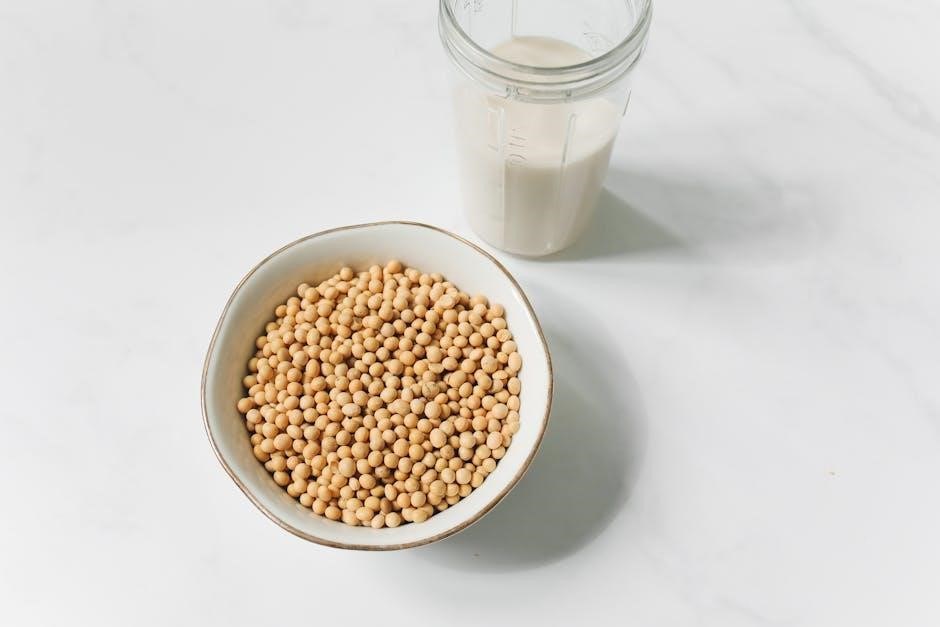A high fiber diet is a key strategy for managing diverticulosis, helping prevent complications and promote regular bowel movements to reduce discomfort and improve overall digestive health.
Understanding Diverticulosis and the Role of Fiber
Diverticulosis is a condition where small pouches, or diverticula, form in the lining of the colon. While often asymptomatic, these pouches can become inflamed, leading to diverticulitis. Fiber plays a crucial role by softening stools, reducing pressure on the colon walls during bowel movements, and preventing further pouch formation. A high-fiber diet helps maintain regular bowel habits and minimizes the risk of complications, making it a cornerstone of managing diverticulosis and promoting long-term digestive health.
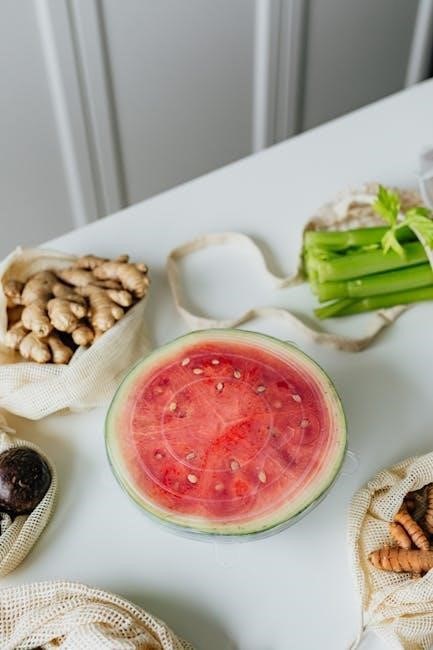
The Benefits of a High Fiber Diet
A high fiber diet reduces inflammation, promotes regular bowel movements, and prevents complications like diverticulitis, supporting overall colon health and digestive well-being effectively.
How Fiber Helps Prevent Diverticulitis
A high-fiber diet plays a crucial role in preventing diverticulitis by softening stools, improving bowel regularity, and reducing pressure in the colon. Fiber helps prevent constipation, which can strain the digestive system and lead to inflammation of diverticula. By adding bulk to stools, fiber ensures smooth passage through the intestines, minimizing irritation and the risk of diverticulitis flare-ups. Additionally, fiber promotes a healthy gut microbiome, which supports immune function and overall digestive health. Incorporating insoluble fiber from whole grains, fruits, and vegetables is particularly beneficial for maintaining colon health and preventing complications.
Improving Bowel Regularity and Reducing Symptoms
A high-fiber diet enhances bowel regularity by adding bulk to stools, making them easier to pass. This reduces the risk of constipation and diarrhea, common symptoms of diverticulosis. Fiber softens stools, decreasing pressure on the colon walls and minimizing discomfort. Regular bowel movements prevent stagnation, which can lead to inflammation. Foods like fruits, vegetables, and whole grains are rich in fiber, promoting a balanced digestive system. Gradually increasing fiber intake and staying hydrated further supports symptom relief and overall gut health.
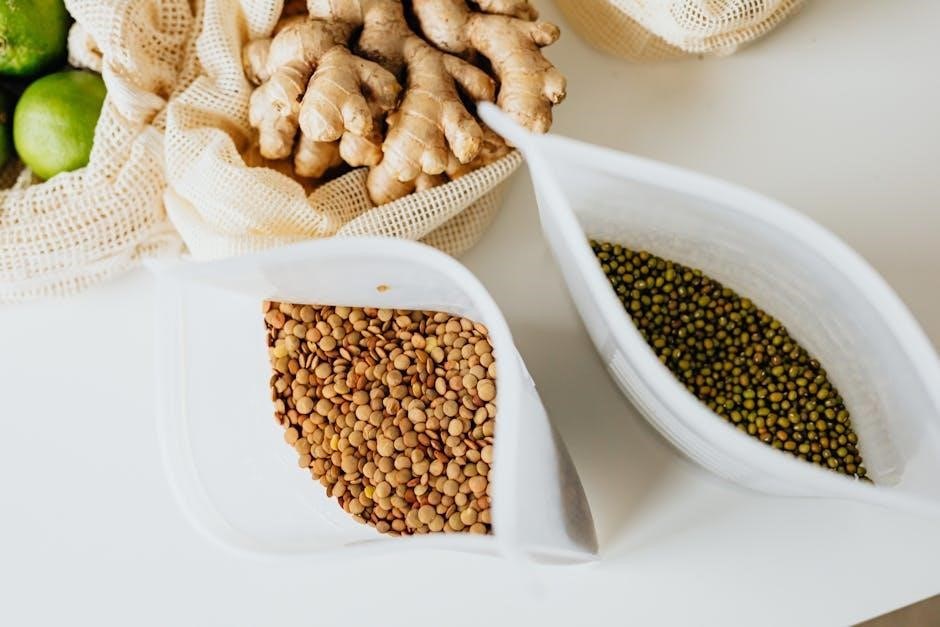
Foods to Include in a High Fiber Diet
- Whole grains like brown rice, quinoa, and wholemeal bread.
- Legumes such as beans, lentils, and peas.
- Fruits like apples, berries, and pears with skins.
- Vegetables, especially broccoli, spinach, and Brussels sprouts.
- Nuts and seeds, including almonds, chia seeds, and flaxseeds.
Whole Grains and Their Fiber Content
Whole grains are rich in dietary fiber, essential for a high-fiber diet. Oats provide about 4 grams per half cup, while brown rice offers 3.5 grams. Quinoa and whole wheat bread contribute around 5 grams per cup and slice, respectively. Incorporating these into meals helps meet daily fiber needs, supporting digestive health and preventing diverticulosis complications. They also contain vitamins and minerals, making them a nutritious choice for overall well-being.
Fruits and Vegetables Rich in Fiber
Fruits and vegetables are excellent sources of dietary fiber, crucial for managing diverticulosis. Apples, berries, and pears provide about 4-5 grams of fiber per serving, while broccoli and spinach offer 5 grams per cup. Root vegetables like carrots and sweet potatoes are also high in fiber, promoting digestive health. Incorporating these foods helps prevent constipation, reduce inflammation, and support the formation of soft, bulky stools, which are easier to pass and reduce pressure on the colon walls.
Legumes, Nuts, and Seeds as Fiber Sources
Legumes, nuts, and seeds are rich in fiber, making them ideal for a high-fiber diet. Lentils, chickpeas, and black beans are excellent sources, providing about 15 grams of fiber per cup. Almonds, chia seeds, and flaxseeds also contribute significantly to daily fiber intake. These foods support healthy digestion, prevent constipation, and reduce the risk of diverticulitis. However, some individuals may need to avoid certain nuts or seeds during acute symptoms to prevent irritation. Incorporating these foods gradually can help maintain a balanced and fiber-rich diet.
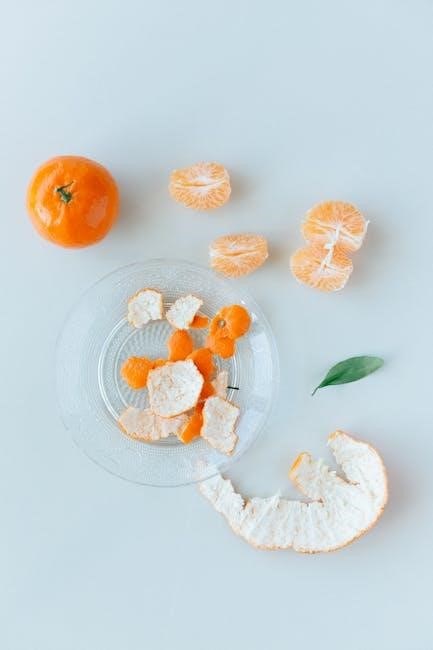
Managing Symptoms with Dietary Adjustments
Managing symptoms involves a temporary low-fiber diet during acute phases, followed by a gradual reintroduction of high-fiber foods and proper hydration to ease digestion.
Low Fiber Diet During Acute Symptoms
A low-fiber diet is crucial during acute diverticulitis symptoms to minimize irritation and allow the digestive system to heal. Focus on foods like white bread, plain rice, bananas, and applesauce; Avoid whole grains, nuts, seeds, and raw vegetables. This temporary adjustment helps reduce inflammation and alleviate discomfort. It’s important to stick to bland, easily digestible foods until symptoms subside, ensuring a smoother recovery and preventing further complications.
Gradual Reintroduction of High Fiber Foods
After acute symptoms subside, gradually reintroduce high-fiber foods to avoid discomfort. Start with low-to-moderate fiber options like cooked vegetables, whole grains, and soft fruits. Monitor for any recurrence of symptoms. Increase fiber intake slowly over weeks to allow the digestive system to adjust. Incorporate foods like brown rice, quinoa, and steamed vegetables. Avoid nuts, seeds, and raw skins initially. This approach helps rebuild tolerance and promotes long-term digestive health without triggering inflammation.
Preventing Complications of Diverticulosis
A high-fiber diet helps prevent complications like diverticulitis by promoting regular bowel movements and reducing colon pressure, which can prevent diverticula from forming or becoming inflamed.
Reducing the Risk of Diverticulitis
A high-fiber diet plays a crucial role in reducing the risk of diverticulitis by promoting regular bowel movements and preventing constipation, which can pressure the colon walls. Fiber adds bulk to stools, easing their passage and reducing the likelihood of diverticula inflammation. Avoiding foods like nuts, seeds, and hulls, which can irritate the diverticula, is also recommended. By maintaining a consistent high-fiber intake, individuals can significantly lower their chances of developing diverticulitis and manage symptoms effectively in the long term.
Long-Term Benefits of a High Fiber Diet
A high-fiber diet offers numerous long-term benefits, including improved colon health and reduced risk of chronic conditions like heart disease and diabetes. It supports healthy gut bacteria, boosting the immune system and enhancing nutrient absorption. Regular consumption of fiber-rich foods also promotes sustained weight management and may lower cholesterol levels. Over time, this dietary approach not only manages diverticulosis but also contributes to overall well-being, making it a sustainable and beneficial choice for long-term health.
Sample Meal Plan for a High Fiber Diet
Include whole grains, fruits, vegetables, and legumes. Breakfast: oatmeal with berries. Lunch: whole-grain bread with lean protein and vegetables. Dinner: fish with roasted vegetables and brown rice.
Breakfast, Lunch, and Dinner Ideas
- Breakfast: Start with oatmeal topped with berries and nuts or scrambled eggs with spinach and whole-grain toast.
- Lunch: Enjoy a salad with mixed greens, chickpeas, and avocado, or a whole-grain wrap with lean poultry and vegetables.
- Dinner: Opt for roasted vegetables with quinoa or brown rice, and include grilled fish or tofu for protein.
Incorporate a variety of colorful, fiber-rich foods to ensure balanced nutrition and support digestive health, helping to manage diverticulosis effectively.
Snacks and Beverages to Support Fiber Intake
- Snacks: Choose fresh fruits like apples or berries, nuts (almonds, walnuts), or veggie sticks with hummus for quick fiber boosts.
- Beverages: Drink plenty of water to aid digestion, and consider herbal teas or low-sugar fruit juices for added hydration and flavor.
These options provide essential fiber and nutrients, supporting digestive health and preventing constipation, while keeping you satisfied between meals.
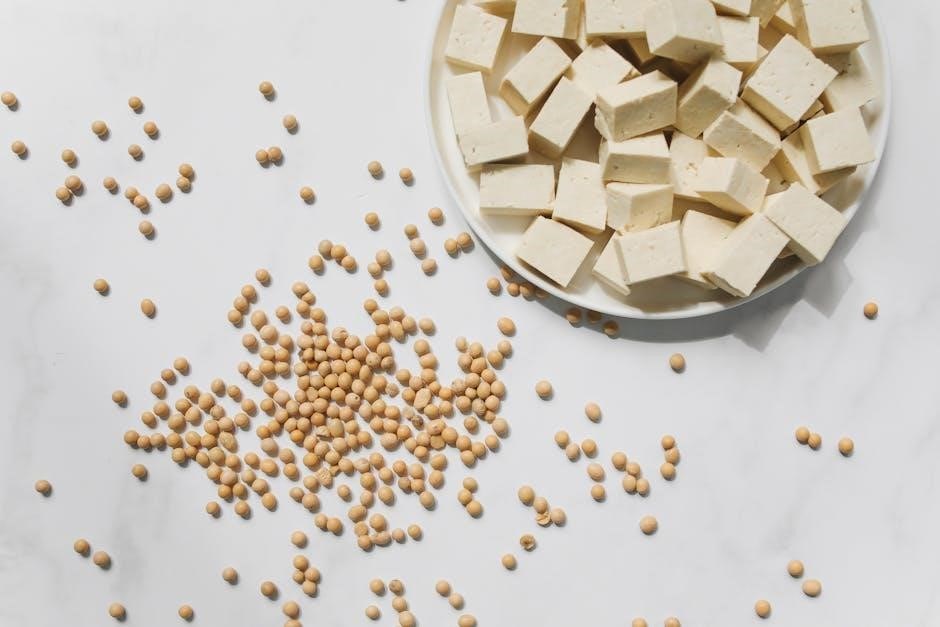
Important Considerations
A high fiber diet for diverticulosis requires careful planning to avoid triggering symptoms. Proper hydration is essential for fiber digestion, and certain foods like nuts or seeds may need to be avoided temporarily during flare-ups to prevent irritation.
Foods to Avoid or Approach with Caution
Certain foods, such as nuts, seeds, and uncooked vegetable skins, can irritate diverticula and should be approached with caution. Processed foods and high-fat or red meat intake may also worsen symptoms. While these foods don’t need to be completely eliminated, they should be avoided during acute flare-ups or introduced gradually in small amounts to assess tolerance. Proper preparation, such as cooking vegetables thoroughly or grinding nuts, can make them easier to digest. Moderation and awareness of how these foods affect symptoms are key to maintaining a balanced high-fiber diet.
Hydration and Its Role in Fiber Digestibility
Hydration is essential for proper fiber digestion, as it helps soften stools and prevent constipation. Drinking 8-10 cups of fluid daily, primarily water, supports fiber absorption and prevents bloating. Inadequate hydration can lead to digestive discomfort, such as gas and cramps. Balancing high fiber intake with sufficient water ensures optimal digestive function and reduces the risk of complications. Staying hydrated is crucial for maximizing the benefits of a high-fiber diet and maintaining overall gastrointestinal health.
A high-fiber diet is effective in preventing diverticulitis, managing symptoms, and promoting long-term digestive health, making it a cornerstone of diverticulosis management and prevention strategies.
A high-fiber diet is essential for managing diverticulosis, reducing the risk of complications like diverticulitis. It promotes regular bowel movements, prevents constipation, and eases symptoms. Include whole grains, fruits, vegetables, legumes, and nuts in your diet. Avoid foods that can irritate diverticula, such as seeds and hard skins. Proper hydration is crucial for fiber digestion. Gradually increase fiber intake to avoid discomfort. A high-fiber diet not only supports digestive health but also offers long-term benefits for overall well-being and disease prevention.
Encouragement to Maintain a High Fiber Diet
Maintaining a high-fiber diet is a proactive step toward better digestive health and long-term well-being. By incorporating whole grains, fruits, and vegetables, you reduce the risk of diverticulitis and promote regular bowel movements. This commitment supports a healthier lifestyle, easing symptoms and preventing future complications. Stay consistent, and over time, you’ll experience the positive impact of a balanced, fiber-rich diet on your overall health and energy levels.
